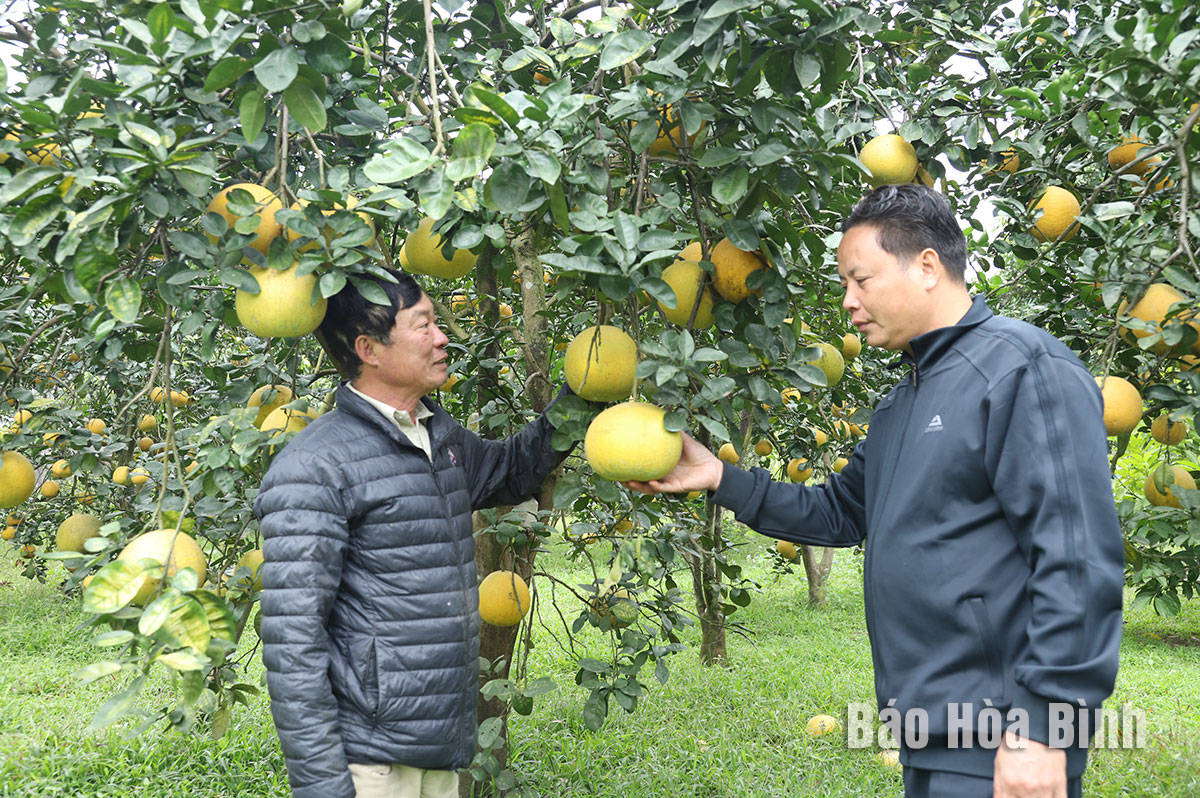
Coming to Khuoc hamlet, Cao Son commune (Luong Son), on the days just before Tet, visitors can immerse themselves in the joyful and exciting atmosphere to welcome the new year of local people. In recent years, the hamlet has been given a facelift. To date, the average per capita income has reached 41 million VND (1,680 USD) a year, the rate of poor households has decreased to 0.9%, and locals’ lives have improved continuously. Few people know that Khuoc used to be one of the 36 most difficult hamlets in Hoa Binh province.

Bui Van Thao (left), Khuoc hamlet,
Cao Son commune (Luong Son) shares his experience in developing citrus growing
model.
Nguyen Huu Mung, Secretary of Khuoc
hamlet's party cell, recalled the time before 2019 when there were no roads and
it would take nearly two hours to go from the hamlet to the commune's office.
Inconvenient roads made people's lives difficult. Transporting goods was mainly
by rudimentary methods; locals had to stock up food for the whole week. From
the State's support capital, in the 2017 – 2018 period, inter-hamlet roads were
built, thus helping change the hamlet’s appearance. New economic models such as
growing citrus and forestry trees have been implemented.
The hamlet currently has 54 households with
223 members belonging to the two ethnic groups of Muong and Dao. In 2012, the
poverty rate was over 70%.
Benefiting from essential infrastructure
projects invested in and built by the State, many local households have
implemented economic models suitable to local climate and soil conditions.
According to statistics, the area of citrus trees in the locality has expanded
by nearly 20 hectares. Some key varieties bring high economic efficiency such
as orange V2, green-skinned pomelo, Dien pomelo and longan. In addition, some
households have focused on planting and exploiting production forests with a
total area of over 30 hectares. Agricultural products are purchased by traders
after harvest.
From support resources of the State, the
local party committee and authorities have effectively taken advantage of
integrated programmes and projects to invest in upgrading essential
infrastructure systems. To date, roads in the hamlet have basically been built,
100% of people have gained access to safe water and electricity, and over 85%
of households have been recognised as "cultural families". Political
security and social order and safety have been maintained.
Bui Minh Chau, Vice Chairperson of the
People's Committee of Cao Son commune, said that thanks to the support of the
Party and State, the lives of people in Khuoc hamlet have changed for the
bettter. In the coming time, the local party committee and authorities will
mobilise maximum resources to continue investing in upgrading essential
infrastructure systems, assisting locals in changing the structure of crops and
livestock to suit the actual conditions at the grassroots. The hamlet is
striving to raise per capita income to over 43 million VND this year.
More than just an information technology teacher, Bui Van Nien is an inspiring figure who has nurtured the scientific curiosity and creative spirit of students in Vietnam’s ethnic minority communities.
Da Bac is the most disadvantaged mountainous district in Hoa Binh province, with ethnic minorities accounting for about 90% of its population. Over the past years, the district has mobilised resources to implement ethnic policies to improve the quality of life of local people.
In recent years, Hoa Binh province has consistently prioritised the protection, care, and education of children, particularly those from ethnic minorities and disadvantaged backgrounds, by creating a safe, healthy, and nurturing environment for their all-round development.
The Steering Committee for Tobacco Harm Prevention and Control of Hoa Binh province, in coordination with the Tobacco Harm Prevention and Control Fund, held a ceremony on May 28 in response to the World No Tobacco Day (May 31) and the National No Tobacco Week (from May 25 to 31). The event was chaired by Nguyen Van Toan, Standing Vice Chairman of the provincial People’s Committee and head of the Steering Committee.
Since 2021, the Center for Industrial Promotion and Industrial Development Consulting (CIIDC) under the Department of Industry and Trade has been implementing a school lighting model as part of the plan for using energy efficiently and economically in Hoa Binh Province in the pẻiod of 2021 - 2025. This model not only aims to improve the learning conditions and enhance the education quality, but it also promotes the message of energy saving, energy security, environmental protection and contributes to the goals of socio-economic development.
In the 2024 - 2025 school year, the entire Hoa Binh provincial education sector includes 520 educational institutions and schools. Among them are 13 ethnic boarding schools with 153 classes and 4,487 students. Four of these schools have met national standards, reaching 30.7 percent.



